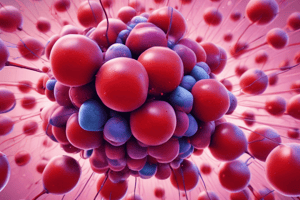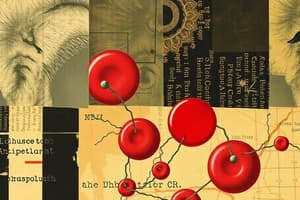Podcast
Questions and Answers
What is the primary mechanism by which antiplatelet drugs prevent clot formation?
What is the primary mechanism by which antiplatelet drugs prevent clot formation?
- Inhibiting the synthesis of vitamin K in the liver, thus affecting clotting factors.
- Inhibiting the formation of clots by interfering with the coagulation cascade.
- Dissolving existing blood clots by attacking and breaking down the fibrin network.
- Preventing platelet aggregation, thereby reducing the clumping of platelets that form a clot. (correct)
Which statement accurately describes the mechanism of action of thrombolytic drugs?
Which statement accurately describes the mechanism of action of thrombolytic drugs?
- They prevent the activation of clotting factors, thereby inhibiting the coagulation cascade.
- They inhibit platelet aggregation, preventing the formation of new clots.
- They directly inhibit the production of thrombin, a key enzyme in clot formation.
- They convert plasminogen to plasmin, which then breaks down the fibrin in existing clots. (correct)
Arterial clots are typically composed of which components?
Arterial clots are typically composed of which components?
- A homogenous mixture of platelets and fibrin
- Predominantly aggregated platelets with minimal red blood cells
- A combination of white and red blood cells (correct)
- Primarily red blood cells enmeshed in a fibrin mesh
How do venous thrombi primarily form?
How do venous thrombi primarily form?
Which of the following statements correctly differentiates the primary action of warfarin from that of heparin?
Which of the following statements correctly differentiates the primary action of warfarin from that of heparin?
What is the primary reason heparin is administered intravenously or subcutaneously rather than orally?
What is the primary reason heparin is administered intravenously or subcutaneously rather than orally?
Why is routine aPTT monitoring typically not required for patients on low-molecular-weight heparin (LMWH) therapy?
Why is routine aPTT monitoring typically not required for patients on low-molecular-weight heparin (LMWH) therapy?
Which statement accurately describes the rationale for avoiding aspirin in patients taking warfarin?
Which statement accurately describes the rationale for avoiding aspirin in patients taking warfarin?
What is the primary mechanism through which Factor Xa inhibitors prevent clot formation?
What is the primary mechanism through which Factor Xa inhibitors prevent clot formation?
Why is it important to discontinue antiplatelet medications, such as aspirin or clopidogrel, several days prior to a surgical procedure?
Why is it important to discontinue antiplatelet medications, such as aspirin or clopidogrel, several days prior to a surgical procedure?
How does Alteplase, a thrombolytic drug, facilitate the breakdown of blood clots?
How does Alteplase, a thrombolytic drug, facilitate the breakdown of blood clots?
In patients with a known warfarin overdose, vitamin K is administered as an antidote. What is the primary mechanism by which vitamin K reverses the effects of warfarin?
In patients with a known warfarin overdose, vitamin K is administered as an antidote. What is the primary mechanism by which vitamin K reverses the effects of warfarin?
What is the primary reason that thrombolytic drugs like Alteplase must be administered within a narrow time window after the onset of symptoms of an acute myocardial infarction (AMI)?
What is the primary reason that thrombolytic drugs like Alteplase must be administered within a narrow time window after the onset of symptoms of an acute myocardial infarction (AMI)?
A patient taking warfarin is prescribed acetaminophen instead of aspirin for pain relief. How does this substitution reduce the risk of complications?
A patient taking warfarin is prescribed acetaminophen instead of aspirin for pain relief. How does this substitution reduce the risk of complications?
Why are patients with low body weight (under 50 kg) typically contraindicated from receiving Factor Xa inhibitors?
Why are patients with low body weight (under 50 kg) typically contraindicated from receiving Factor Xa inhibitors?
What is the primary mechanism by which clopidogrel (Plavix) inhibits platelet aggregation?
What is the primary mechanism by which clopidogrel (Plavix) inhibits platelet aggregation?
Which of the following laboratory tests is most frequently used to monitor the therapeutic effects of warfarin?
Which of the following laboratory tests is most frequently used to monitor the therapeutic effects of warfarin?
Why should Dong quai, feverfew, garlic, ginger, Korean ginseng, saw palmetto and ginkgo biloba be used with caution in people who are taking antiplatelet drugs?
Why should Dong quai, feverfew, garlic, ginger, Korean ginseng, saw palmetto and ginkgo biloba be used with caution in people who are taking antiplatelet drugs?
What is the role of heparinase in the context of heparin therapy?
What is the role of heparinase in the context of heparin therapy?
Which patient population needs to exercise special caution with clopidogrel and other antiplatelet medications.
Which patient population needs to exercise special caution with clopidogrel and other antiplatelet medications.
Flashcards
Anticoagulants
Anticoagulants
Drugs that prevent the formation of blood clots, inhibiting circulation.
Antiplatelets
Antiplatelets
Medications preventing platelet aggregation, stopping platelets from clumping together to form a clot.
Thrombolytics
Thrombolytics
Attack and dissolve already formed blood clots.
Thrombosis
Thrombosis
Signup and view all the flashcards
Embolism
Embolism
Signup and view all the flashcards
Heparin
Heparin
Signup and view all the flashcards
Low-Molecular-Weight Heparins
Low-Molecular-Weight Heparins
Signup and view all the flashcards
Warfarin
Warfarin
Signup and view all the flashcards
Oral Anticoagulants
Oral Anticoagulants
Signup and view all the flashcards
Factor Xa Inhibitors
Factor Xa Inhibitors
Signup and view all the flashcards
Antiplatelet Drugs
Antiplatelet Drugs
Signup and view all the flashcards
Thrombolytics
Thrombolytics
Signup and view all the flashcards
Study Notes
- Categories of drugs used to maintain or restore circulation include anticoagulants, antiplatelets (antithrombotics), and thrombolytics.
Anticoagulants
- Anticoagulants prevent the formation of clots and inhibit circulation.
- They prevent the formation of new clots.
- Anticoagulants are used in patients with venous and arterial disorders that put them at high risk for clot formation.
- Venous problems include deep venous thrombosis (DVT) and pulmonary embolism (PE); arterial problems include coronary thrombosis, myocardial infarction (MI), presence of artificial heart valves, and cerebrovascular accident (CVA), or stroke.
- Oral and parenteral anticoagulants (warfarin and heparin, e.g.) primarily prevent venous thrombosis, while antiplatelet drugs act to prevent arterial thrombosis.
- Both groups of drugs generally suppress thrombosis.
- Heparin is a natural substance in the liver that prevents clot formation.
- It was first used in blood transfusions to prevent clotting.
- Heparin is indicated for a rapid anticoagulant effect when a thrombosis occurs due to DVT, PE, or an evolving stroke.
- Heparin is also used in open-heart surgery to prevent blood from clotting and in critically ill patients with disseminated intravascular coagulation (DIC), which occurs when fibrin clots form within the vascular system.
- Heparin is poorly absorbed through the gastrointestinal (GI) mucosa and is destroyed by heparinase, a liver enzyme.
- Because of poor oral absorption, heparin is given subcutaneously for prophylaxis or intravenously to treat acute thrombosis.
- It can be administered as an IV bolus or in IV fluid for continuous infusion.
- Heparin prolongs clotting time and is monitored using partial thromboplastin time (PTT) and activated partial thromboplastin time (aPTT) laboratory tests.
- Heparin can decrease the platelet count, causing thrombocytopenia.
- If hemorrhage occurs during heparin therapy, protamine sulfate, an anticoagulant antagonist, is given intravenously.
- Oral therapy with warfarin is typically started before discontinuing heparin.
Low-Molecular-Weight Heparins
- Derivatives of standard heparin were introduced to prevent venous thromboembolism (enoxaparin and dalteparin, e.g.).
- Low-molecular-weight heparin can provide equivalent anticoagulation with a lower risk of bleeding.
- Low-molecular-weight heparins (LMWHs) produce more stable responses at recommended doses.
- Frequent laboratory monitoring of aPTT is not required.
- LMWHs are commonly prescribed to prevent DVT and acute PE after orthopedic or abdominal surgery.
- Hip and knee replacement anticoagulant therapy often includes enoxaparin, and abdominal surgery includes dalteparin.
- The drugs can be administered at home because aPTT monitoring is not necessary, whereas heparin must be given in the hospital.
- LMWHs are administered subcutaneously once or twice a day, depending on the drug or drug regimen, and they are prefilled syringes with attached needles.
- The patient or family member is taught how to administer the subcutaneous injection, usually in the abdomen, alternating injection sites with every dose.
- The average treatment period lasts 7 to 10 days.
- LMWH is usually started in the hospital within 24 hours after surgery.
- The half-life of LMWHs is two to four times longer than that of heparin.
- Patients should be instructed not to take antiplatelet drugs such as aspirin while taking LMWHs or heparin.
- LMWH overdose is rare; if bleeding occurs, protamine sulfate is the anticoagulant antagonist used (1 mg of protamine sulfate for every 100 units of unfractionated heparin or LMWH given).
- LMWHs are contraindicated for patients with strokes, peptic ulcers, and blood anomalies.
- They should not be given to patients having eye, brain, or spinal surgery.
Oral Anticoagulants
- Oral anticoagulants (warfarin, e.g.) inhibit hepatic synthesis of vitamin K, affecting clotting factors II, VII, IX, and X.
- Warfarin is an oral anticoagulant used mainly to prevent thromboembolic conditions such as thrombophlebitis, PE, and embolism formation caused by atrial fibrillation, which can lead to stroke.
- Oral anticoagulants prolong clotting time and are monitored by prothrombin time (PT), a laboratory test.
- Today, the international normalized ratio (INR) is the laboratory test most frequently used to report PT results.
- Normal INR is 1.3 to 2; patients on warfarin therapy are maintained at an INR of 2 to 3.
- Monitoring INR at regular intervals is required for the duration of drug therapy.
- Drug accumulation can occur and can lead to external or internal bleeding, so the nurse must observe for petechiae, ecchymosis, tarry stools, and hematemesis and teach the patient to do the same at home.
- The antidote for warfarin overdose is vitamin K, but it takes 24 to 48 hours to be effective.
- Warfarin is well absorbed through the GI mucosa; food delays but does not inhibit absorption.
- Warfarin's half-life is 20 to 60 hours.
- Because warfarin has a long half-life and is highly protein-bound, the drug can have cumulative effects.
- Bleeding can occur, especially if another highly protein-bound drug is administered with warfarin.
- Kidney and liver disease prolong the half-life of both heparin and warfarin.
- Warfarin is metabolized to inactive metabolites excreted in urine and bile.
- Warfarin is effective for long-term anticoagulant therapy.
- Warfarin use is not recommended during pregnancy.
- Warfarin has a long onset of action, peak concentration, and duration of action, so drug accumulation may occur.
- Bleeding (hemorrhage) is the major adverse effect of warfarin.
- Patients should be monitored closely for signs of bleeding such as petechiae, ecchymosis, GI bleeding, ocular hemorrhage, and hematuria.
- Laboratory testing of PT or INR should be scheduled at recommended intervals.
- Because warfarin is highly protein-bound, it is affected by drug interactions.
- Aspirin, nonsteroidal antiinflammatory drugs (NSAIDs), other types of antiinflammatory drugs, sulfonamides, phenytoin, cimetidine, allopurinol, and oral hypoglycemic drugs for diabetes can displace warfarin and cause more free-circulating anticoagulant.
- Numerous other drugs increase the action of warfarin, and bleeding is likely to occur.
- Acetaminophen should be used instead of aspirin by patients taking warfarin.
- Alternative therapies, such as Dong quai, feverfew, garlic, ginger, meadowsweet, willow bark, chamomile tea, ginkgo, and bilberry, may increase bleeding when taken with anticoagulants.
- Ginseng may decrease the effects of warfarin, thereby decreasing INR.
- Alfalfa may decrease anticoagulant activity.
- Goldenseal may decrease the effects of heparin and oral anticoagulants.
- Hawthorn increases the action of anticoagulants.
- Valerian and green tea may decrease the effects of warfarin.
- Cranberry may increase INR.
Factor Xa Inhibitors
- Factor Xa inhibitors include fondaparinux (given subcutaneously) and rivaroxaban, apixaban, edoxaban, and betrixaban (given orally).
- These drugs do not require routine coagulation monitoring and are given once or twice daily.
- Factor Xa inhibitors selectively block the activity of clotting factor Xa to prevent clot formation.
- They are approved for the prevention of DVT and PE.
- Bleeding is the major adverse effect.
- This drug category should not be given to patients weighing less than 50 kg because low body weight increases the risk for bleeding.
Antiplatelet Drugs
- Antiplatelets are used to prevent thrombosis in the arteries by suppressing platelet aggregation.
- Heparin and warfarin prevent thrombosis in the veins.
- Main uses for prophylactic include prevention of MI or stroke for patients with a family history of these, prevention of repeat MI or stroke and prevention of stroke for patients having transient ischemic attacks (TIAs).
- Long-term, low-dose aspirin therapy has been found to be both an effective and inexpensive treatment for suppressing platelet aggregation.
- Aspirin inhibits cyclooxygenase (COX).
- For patients with a family history of stroke or MI, the recommended aspirin dose is 50 to 325 mg/day for stroke prophylaxis and 75 to 162 mg/day for MI prophylaxis.
- Because aspirin has prolonged antiplatelet activity, it should be discontinued at least 7 days before surgery.
- Other antiplatelet drugs include clopidogrel, prasugrel, ticagrelor, abciximab, eptifibatide.
- Clopidogrel is used after MI or stroke to prevent a second event and may be prescribed singly or with aspirin.
- Clopidogrel inhibits platelet aggregation and prevents ADP from binding with the ADP platelet receptor.
- Contraindications associated with clopidogrel are intracranial hemorrhage and GI bleeding.
- Caution should always be exercised, including for hepatic/renal disease, surgery, peptic ulcer, thrombotic thrombocytopenia purpura, trauma, older adults, pregnancy, and breastfeeding.
- Clopidogrel is rapidly absorbed and highly protein-bound.
- The half-life is 6 hours; it is usually prescribed once a day.
- Excretion of the drug metabolite occurs equally in the urine and feces.
- Clopidogrel prevents platelet aggregation by blocking the binding of ADP to the platelet ADP receptor.
- Clopidogrel prolongs bleeding time and should be discontinued for 7 days preceding surgery.
- The onset of action and peak of clopidogrel is dependent on dosage.
- Side effects include abdominal pain, dizziness, confusion, epistaxis, headaches, hematoma, dyspepsia, diarrhea, constipation, purpura, peripheral edema, rash, and pruritus.
- Life-threatening reactions can include agranulocytosis, aplastic anemia, thrombocytopenia, pancytopenia, hepatic failure, and Stevens-Johnson syndrome.
- Dong quai, feverfew, garlic, ginger, Korean ginseng, saw palmetto, and ginkgo biloba interfere with platelet aggregation.
- When these herbs are taken with an antiplatelet drug such as aspirin, increased bleeding may occur.
- Licorice may cause hypokalemia which can potentiate drug toxicity.
- St. John's wort with clopidogrel may potentiate drug effects.
Thrombolytics
- Thromboembolism, or occlusion of an artery or vein caused by a thrombus or embolus, results in ischemia (deficient blood flow) that causes necrosis (death) of the tissue.
- It takes approximately 1 to 2 weeks for the blood clot to disintegrate by natural fibrinolytic mechanisms.
- If a new thrombus or embolus can be dissolved more quickly, tissue necrosis is minimized, and blood flow to the area is reestablished faster.
- Thrombolytics have been used to convert plasminogen to plasmin, which destroys the fibrin in the blood clot.
- The thrombus, or blood clot, disintegrates when a thrombolytic drug is administered as soon as possible after symptoms of an acute myocardial infarction (AMI), acute heart attack.
- Ideally, the thrombolytic should be administered within 3 to 4 hours or within 30 minutes after arriving at the hospital for treatment; however, benefits may be seen when administered within 12 hours after initial symptoms.
- Necrosis resulting from the blocked artery is prevented or minimized, and hospitalization time may be decreased.
- These drugs are also used for PE, DVT, noncoronary arterial occlusion from an acute thromboembolism, and thrombotic stroke.
- Commonly used thrombolytics include alteplase (tPA) and tenecteplase (TNK tPA).
- Alteplase promotes fibrinolysis associated with thrombosis in patients with AMI, PE, ischemic stroke, and occluded IV catheters.
- Alteplase promotes the conversion of plasminogen to plasmin, an enzyme that digests the fibrin matrix of clots, and also initiates fibrinolysis.
- Alteplase has an immediate onset of action, a peak effect in 5-10 minutes, and a duration of 1 hour after IV administration.
- Contraindications include intracranial bleeding, aneurysm, CVA, brain tumor, head trauma, thrombocytopenia, and coagulopathy.
- Caution should be exercised for atrial fibrillation, hepatic/renal disease, CABG, bleeding, peptic ulcer disease, diabetic retinopathy, older adults, and pregnancy.
- Side effects include epistaxis, infection, ecchymosis, nausea, and vomiting.
- Life-threatening adverse reactions include stroke, dysrhythmias, pulmonary edema, and renal failure.
Thrombosis
- Thrombosis is the formation of a clot in an arterial or venous vessel.
- Causes include blood stasis (decreased circulation), platelet aggregation on the blood vessel wall, or blood coagulation.
- Arterial clots are usually made up of both white and red clots.
- Blood clots in the veins arise from platelet aggregation with fibrin that attaches to red blood cells.
- Both types of thrombus can be dislodged from the vessel and become an embolus, a blood clot moving through the bloodstream.
Studying That Suits You
Use AI to generate personalized quizzes and flashcards to suit your learning preferences.




